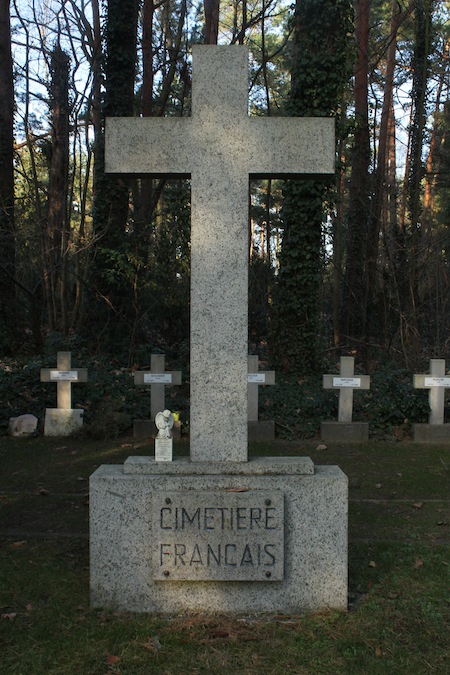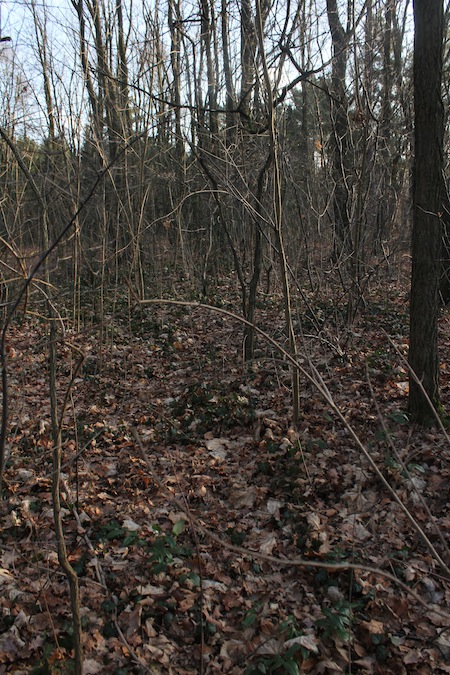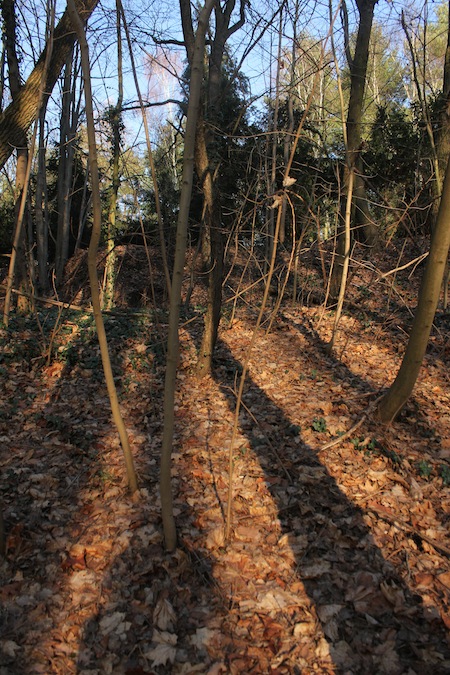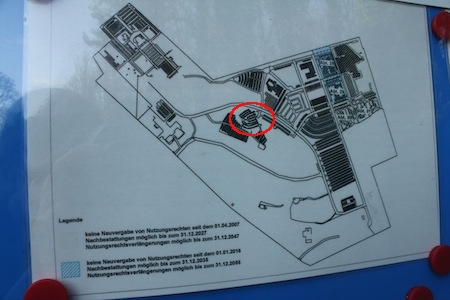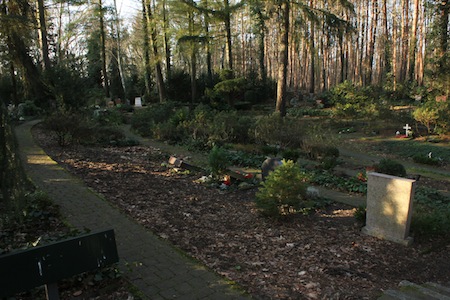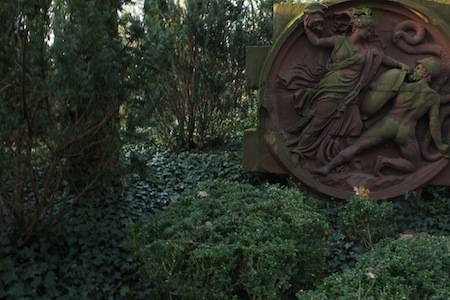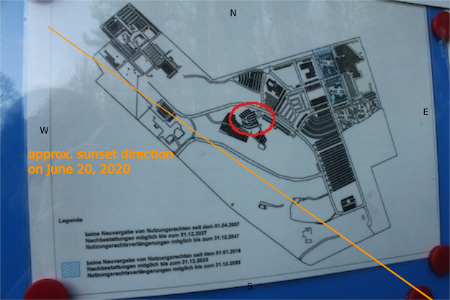Friedhof Heiligensee

Sandhauser Strasse in Heiligensee next to the old riflemans house
In the randform post Heiligensee I hypothesized that an ancient oral tradition from the village of Heiligensee might indicate that cults of the germanic goddess Nerthus could have taken place there. I am fully aware that this is super speculative and in particular that it is outrageously unlikely that there is an oral tradition in Berlin which is 1500-to 4000 years old (thats approx. when the semnones lived there). It would not be too far fetched to assume that the tales of Nerthus were converted into tales matching the surroundings of Heiligensee. Nevertheless it should be reminded of that there are oral traditions which lastet for rather long time like the vedas (with by the way interesting error correcting schemes).
Anyways for me the the oral tradition was so compelling close to the Nerthus tales and to the fact that there might have been an ancient sacred location that I was motivated enough to travel to the other side of Berlin and to look for something like a sacred grove, a thing location on a raised mound and/or even a tumulus like in Old Uppsala. That is I looked at the hills across from Sandhauserstr.99 which are called Schifferberge. It should be said that in this area dune hills are rather common, so that when I started out I was quite convinced that the option tumulus was rather a joke. That is I was convinced that the Schifferberge are just dunes instead of containing a tumulus, but I am not so sure anmore. But see the images.

Schifferberge across the old riflemans house
I already mentioned in the previous post that there is a cemetary.

Entrance to the cemetary by the district of Berlin Reinickendorf
The cemetary is rather large. As a very rough estimation, the long diameter could be easily a kilometer.
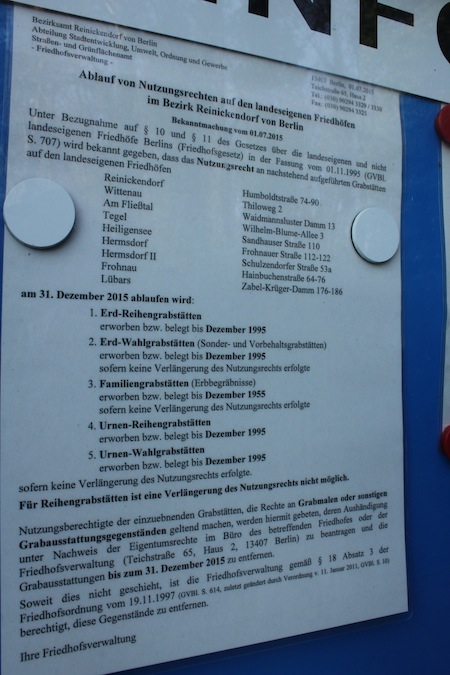
Anouncement of the cemetary administration
The announcement reminds amongst others that the use of socalled Reihengräber (literally “row graves”) can’t be prolonged: “Für Reihengrabstätten ist eine Verlängerung des Nutzungsrechts nicht möglich.”
At some places the cemetary looks almost like a park.
But there are also more graveyard typical installments.

Typical location where people fill their watering cans.

Shed for storing watering cans.
The sign says: “Wir bitten Sie die Gießkannen bis spätestens zum Totensonntag abzunehmen. Ansonsten erfolgt Entfernung durch die Friedhofsverwaltung.”, translation “We kindly ask you to remove the watering cans until Sunday of the Dead. Otherwise removal will be enforced by the cemetery administration.”
But there was anyways only one watering can hanging in the shed.
The cemetary hosts a section which was reserved for the french forces in Berlin:
It hosts the grave of Jacquinot de Besange who saved a lot of lives in the battle of Shanghai.

plate commemorating Robert Emile Jacquinot de Besange
The river Havel (on google maps) is hard to see through all the trees:
In general some part of the cemetary looks quite like a forest and paths are winding up and down the hill.
It was such all too easy to identify all sorts of traces or non-traces.
One striking feature was however the terrace kind of built-up of the main hill, which one can see in the next two images.
Of course there could have easily been some ancient pathway or some older (concrete?) reenforcements for the part of the cemetery which is on top of that hill, but still for the time being the hill has a structure which is unlikely completely natural.
And finally the -what I found- most enigmatic part of the cemetary was right on top of that hill. There is a kind of elliptically arena shaped recess. The long diameter is about 50 m. In the map its I think where I made a red mark, but I looked at the map only later:
The recess is elliptically traced out by terraced paths along the graves. If there would be a canonical location for a sacred grove or thing then it would be here:
But, as said, the hill could just be dunes. In particular I have no glimpse how geologically stable it is and to what extend whatsoever fortifications and/or (ancient) constructions took place.
Anyways it seems I was not the only one who found that this central spot is rather special. In the woods right on the slope of the recess someone placed this relief-like sculpture:
It is interesting to look a bit into what this sculpture is about, even if it might have been dumped there half accidentally.
According to the blogpost Pergamon in Heiligensee of the blog “Neue Kunstspaziergänge” the sculpture was part of a in 2000 demolished Berlin bridge called “Wiener Brücke” and according to the Lexicon Edition Luisenstadt it shows a scene from the famous Pergamon altar.
The Pergamon altar is usually on display in the Pergamon museum in the center of Berlin. There are though currently big (unfortunately in my opinion not all are really favorable) restructurings of the Pergamon museum. Due to this -amongst others- the Pergamon altar will not be visible at least until late 2019. So the museum is trying to mitigate this invisibility by more online activities like a 3D version of the Altar and a sofar technical draft of a 3D Detail.
I tried to figure out who the sculpture is supposed to show and apart from the strange vase with the serpent around it could have eventually been Telephus and Auge. But its not – thanks to this sketch I found out that the sculpture is supposed to display Nyx! And knowing the name of this part of the Altar it was possible to find it easily in the Museum Collection.
Nyx is the goddess of night and daughter of Chaos. According to Hesiod and Wikipedia:
With Erebus (Darkness), Nyx gives birth to Aether (Brightness) and Hemera (Day).[4] Later, on her own, Nyx gives birth to Moros (Doom, Destiny), Ker (Destruction, Death), Thanatos (Death), Hypnos (Sleep), the Oneiroi (Dreams), Momus (Blame), Oizys (Pain, Distress), the Hesperides, the Moirai (Fates), the Keres, Nemesis (Indignation, Retribution), Apate (Deceit), Philotes (Friendship), Geras (Old Age), and Eris (Strife)
update Nov. 8, 2020:
Please have a look at this comment, where in particular it is assessed that if you look at the direction of the sunset on June 20 (midsummer) in Berlin-Tegel then the sunset on June 20 is approximately:
Unfortunately I sofar couldn’t find any height map for the area, but I think I remember that the bigger pathways on the cemetery were more or less around the hill and that the hill more or less parallel to Sandhauser Str. That would mean that the hill is pointing in direction of the sunset on midsummer – just like it is apparently the case for the burial mounds at Devil’s Jump.





